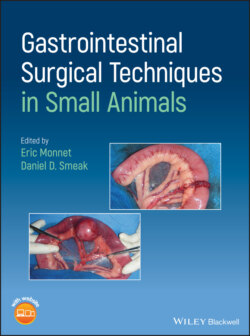Читать книгу Gastrointestinal Surgical Techniques in Small Animals - Группа авторов - Страница 39
References
Оглавление1 Arbaugh, M. et al. (2013). Biomechanical comparison of glycomer 631 and glycomer 631 knotless for use in canine incisional gastropexy. Vet. Surg. 42 (2): 205–209.
2 Booth, H.W. (2003). Suture materials, tissue adhesives, staplers, and ligating clips. In: Textbook of Small Animal Surgery, 3e (ed. D. Slatter), 234–244. Philadelphia: Saunders.
3 Capperauld, I. (1989). Suture materials: a review. Clin. Mater. 4 (1): 3–12.
4 Chih‐Chang, C. and Williams, D.F. (1984). Effects of physical configuration and chemical structure of suture materials on bacterial adhesion: A possible link to wound infection. Am. J. Surg. 147 (2): 147–204.
5 Chu, C.C., Von Franhofer, J.A., Greisler, H.P. et al. (eds.) (1997). Wound Closure Biomaterials and Devices. New York: CRC Press.
6 Chu, C.C. and Williams, D.F. (1984). Effects of physical configuration and chemical structure of suture materials on bacterial adhesion. A possible link to wound infection. Am. J. Surg. 147 (2): 197–204.
7 Coolman, B.R. et al. (1999). Evaluation of a skin stapler for belt‐loop gastropexy in dogs. J. Am Anim. Hosp. Assoc. 35 (5): 440–444.
8 Coolman, B.R. et al. (2000). Comparison of skin staples with sutures for anastomosis of the small intestine in dogs. Vet. Surg. 29 (4): 293–302.
9 Corman, M.L. et al. (1989). Comparison of the valtrac biofragmentable anastomosis ring with conventional suture and stapled anastomosis in colon surgery. Results of a prospective, randomized clinical trial. Dis. Colon Rectum 32 (3): 183–187.
10 Denyttenaera, S.V. et al. (2009). Barbed suture for gastrointestinal closure: A randomized control trial. Surgical Innovation. 16 (3): 237–242.
11 Domnick, E.D. (2014). Suture material and needle options in oral and periodontal surgery. J. Vet. Dentistry 31 (3): 204–211.
12 Erhart, N.P. et al. (2013). In vivo assessment of absorbable knotless barbed suture for single layer gastrotomy and enterotomy closure. Vet. Surg. 42 (2): 210–216.
13 Ferrer‐Marquez, M. and Belda‐Lorano, R. (2009). Barbed sutures in general and digestive surgery. Cirugia Espanola. 94 (2): 65–69.
14 Freudenberg, S. et al. (2004). Biodegradation of absorbable sutures in body fluids and pH buffers. Eur. Surg. Res. 36 (6): 376–385.
15 Hansen, L.A. and Monnet, E.L. (2012). Evaluation of a novel suture material for closure of intestinal anastomoses in canine cadavers. Am. J. Vet. Res. 73 (11): 1819–1823.
16 Hardy, T.G. Jr. et al. (1987). Initial clinical experience with a biofragmentable ring for sutureless bowel anastomosis. Dis. Colon Rectum 30 (1): 55–61.
17 Hoer, J., et al. (2001). Influence of suture technique on laparotomy wound healing: An experimental study in the rat. Langenbeck’s archives of surgery/Deutsche Gesellschaft fur Chirurgie 386 (3): 218–223.
18 Masini, B.D. et al. (2011). Bacterial adherence to suture materials. J. Surg. Educ. 68 (2): 101–104.
19 Marturello, D.M. et al. (2014). Knot security and tensile strength of suture materials. Vet. Surg. 43 (1): 73–79.
20 Osterberg, C.A. (1983). Enclosure of bacteria within capillary multifilament sutures as protection against leukocytes. Acta Chir. Scand. 149 (7): 663–668.
21 Ryan, S. et al. (2006). Comparison of biofragmentable anastomosis ring and sutured anastomoses for subtotal colectomy in cats with idiopathic megacolon. Vet. Surg. 35 (8): 740–748.
22 Smeak, D.D. (1998). Selection and use of currently available suture materials and needles. In: Current Techniques in Small Animal Surgery, 4e (eds. M.J. Bojrab et al.), 19–26. Philadelphia: Williams and Wilkins.
23 Thiede, A. et al. (1998). Overview on compression anastomoses: biofragmentable anastomosis ring multicenter prospective trial of 1666 anastomoses. W. J. of Surg. 22 (1): 78–87.
24 Thornton, F.J. and Barbul, A. (2014). Healing in the gastrointestinal tract. Surg. Clin. N. Am. 77 (3): 549–573.
25 Zimmer, C.A. et al. (1991). Influence of knot configuration and tying technique on the mechanical performance of sutures. J. Emerg. Med. 9 (3): 107–113.
